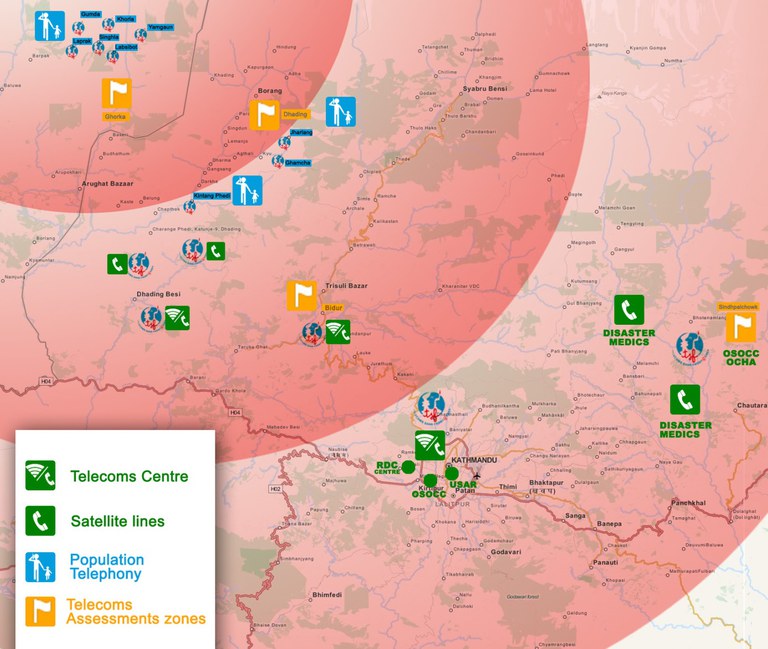Gorkha Earthquake
Context: Earthquake
Start date: 26/04/2015
End date: 04/06/2015
Areas of intervention: 5 districts
- Katmandou
- Dhading
- Ghorka
- Nuwakot
- Sindhulpalchok
Activities:
- Support to coordination
- UNDAC support
- Humanitarian calling operations
20 NGOs & agencies supported
7.2 GB of data transferred
2,998 minutes of calls
7,430 indirect beneficiaries
Context
On 25th April 2015, a devastating 7.8 magnitude earthquake hit Nepal. Located in the Lamjung district, north of the capital of Kathmandu, it caused numerous landslides and extensive damages resulting in the destruction of many buildings. A second 7.3 magnitude earthquake, hitting on May 12th in Sindhupalchok, a district east of Kathmandu, considerably worsened the situation. The earthquakes collectively caused the deaths of more than 8,800 people in the country.
Located between China and India, along the Himalayas, Nepal has one of the most rugged reliefs in the world. This complex topography presented multiple challenges for the humanitarian response. The already underdeveloped road infrastructure was devastated by landslides and mountain roads blocked, causing the isolation of many communities.
Additionally, the partial destruction of communication networks and power grids increased the difficulty of access in the most affected areas close to the epicentre, making it impossible to deliver humanitarian aid for more than a week.
Deployment
It was essential for Télécoms Sans Frontières to respond to this lack of means of communication until the restoration of land and mobile telephone networks. On 26th April, a first team was deployed from the TSF headquarters and the Asia-Pacific base to reach Kathmandu, the capital of Nepal, boarding the first commercial flight authorised to land. The team was reinforced as the mission progressed.
Support to coordination
Upon arrival, TSF immediately supported the USAR teams (Urban Search and Rescue) mobilised by more than 14 countries: Belgium, Canada, China, France, Germany, Norway, Japan, Spain, the Netherlands, the United States, Poland, the United Kingdom, Singapore and Switzerland.
TSF deployed a satellite internet connection to enable the On-Site Operations Coordination Centre (OSOCC), led by the United Nations Office for the Coordination of Humanitarian Affairs (OCHA), to coordinate all search and rescue operations. This connection enabled the USAR units to conduct assessments of the situation, to divide rescue missions among the different teams and to map the devastated areas. This phase is critical and can save the lives of people still buried under rubbles. Beyond the first 72 hours, the chances of survival are extremely low.
A second satellite Internet connection was installed at the United Nations Reception/Departure Centre (RDC) on 30th April. Based at Kathmandu airport, the RDC is responsible for registering humanitarians arriving in Nepal and informing them of the situation by sharing essential information to accelerate the beginning of their operations.
In addition, TSF supported many NGOs in the field to accelerate their response capacity. TSF supported the NGO ACTED and other humanitarians based in the city of Dhading Besi, located 50 km west of Kathmandu in the Dhading District, by installing satellite Internet access in their offices. All of them benefited from this connection to ensure the efficient supply of logistics from Kathmandu.
TSF teams also supported Handicap International's activities in Bidur, Nowakot District. In charge of the logistic hub at the entrance to the Langtang Valley, Handicap International provided the supply and storage of equipment and materials for distribution by other humanitarian organisations operating in this district. An Internet connection was therefore essential to organise and coordinate the transport and storage of these deliveries from Kathmandu to the affected and isolated communities.
Finally, TSF assisted the organisation Disaster Medics, specialised in medical interventions, with the equipment of a localisation and communication system. Thus, whatever their area of intervention, the Disaster Medics teams were able to signal their position and send alert messages to request helicopter evacuation, especially when the condition of the wounded they treated required emergency transfer to the hospital.
Humanitarian calling operations
The TSF teams moved through the Himalayas from village to village to offer to isolated families national or international phone calls. These operations allowed them to reassure their loved ones, to ask for help or, more importantly, to inform them that they were still alive.
One team from TSF set up operations in the remote communities of Barpak, and Laprak. Installed in a tent among the survivors of the earthquake, the team spent several days covering the valley to cover all the communities in need.
In total, 770 households received 2,998 minutes of calls.































